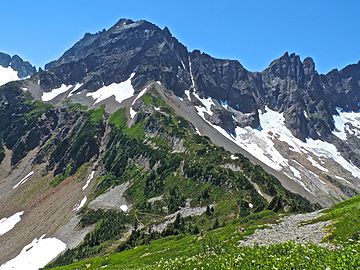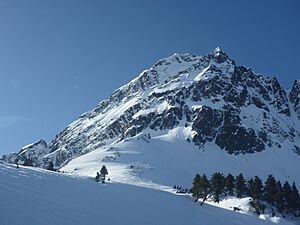Mix-up Peak facts for kids
Quick facts for kids Mix-up Peak |
|
|---|---|

Mix-up Peak seen from Sahale Arm Trail
|
|
| Highest point | |
| Elevation | 7,440 ft (2,270 m) |
| Prominence | 640 ft (200 m) |
| Isolation | 1.03 mi (1.66 km) |
| Parent peak | Magic Mountain |
| Geography | |
| Location | Washington, U.S. |
| Parent range | North Cascades |
| Topo map | USGS Cascade Pass |
| Climbing | |
| First ascent | 1947, Wesley Grande, Jack Kendrick |
| Easiest route | Glacier travel, class 4 scrambling |
Mix-up Peak, also called Mixup Peak, is a tall mountain in Washington state. It stands about 7,440 feet (2,268 meters) high. This peak is found on the border between Skagit County and Chelan County.
Mix-up Peak is part of the North Cascades mountain range. It is located about one mile south of Cascade Pass. The mountain also sits on the edge of North Cascades National Park and Glacier Peak Wilderness. The closest mountain that is taller is Magic Mountain, which is about one mile to the east-southeast. Mix-up Peak is at the start of the Ptarmigan Traverse. This is a challenging mountain route that leads to remote peaks like Mount Formidable and Dome Peak. The Cache Glacier is a large ice field on its eastern side. Water from the east side of the mountain flows into the Stehekin River. Water from the west side drains into the Cascade River.
Weather at Mix-up Peak
Mix-up Peak is in a marine west coast climate zone. This means it gets a lot of moisture from the ocean. Most weather systems start over the Pacific Ocean. They then travel northeast towards the Cascade Mountains.
When these weather systems reach the North Cascades, the mountains force the air upward. This causes the air to cool and drop its moisture. This moisture falls as rain or snow on the Cascades. This process is called Orographic lift. Because of this, the western side of the North Cascades gets a lot of rain and snow. This is especially true during the winter months.
In winter, the weather is often cloudy. But in summer, high-pressure systems over the Pacific Ocean bring clear skies. This means there is often little or no cloud cover. Because of the ocean's influence, the snow tends to be wet and heavy. This can lead to a high risk of avalanches.
How Mix-up Peak Formed
The North Cascades have very rugged land. You can see jagged peaks, sharp ridges, and deep glacial valleys. Geological events that happened millions of years ago created this varied landscape. These events also caused big changes in elevation. These changes led to different climates and types of plants in the area.
The Cascade Mountains began to form millions of years ago. This was during the late Eocene Epoch. The North American Plate was slowly moving over the Pacific Plate. This movement caused many volcanic eruptions. Also, small pieces of the Earth's crust, called terranes, helped form the North Cascades. This happened about 50 million years ago.
During the Pleistocene period, which was over two million years ago, glaciers grew and shrank many times. As they moved, they scraped away the land. This left behind piles of rock debris. The river valleys in the area have a "U"-shape. This shape was created by these recent glaciers. The rising of the land (called uplift) and cracks in the Earth's crust (called faulting) worked with the glaciers. Together, these processes created the tall peaks and deep valleys of the North Cascades.




